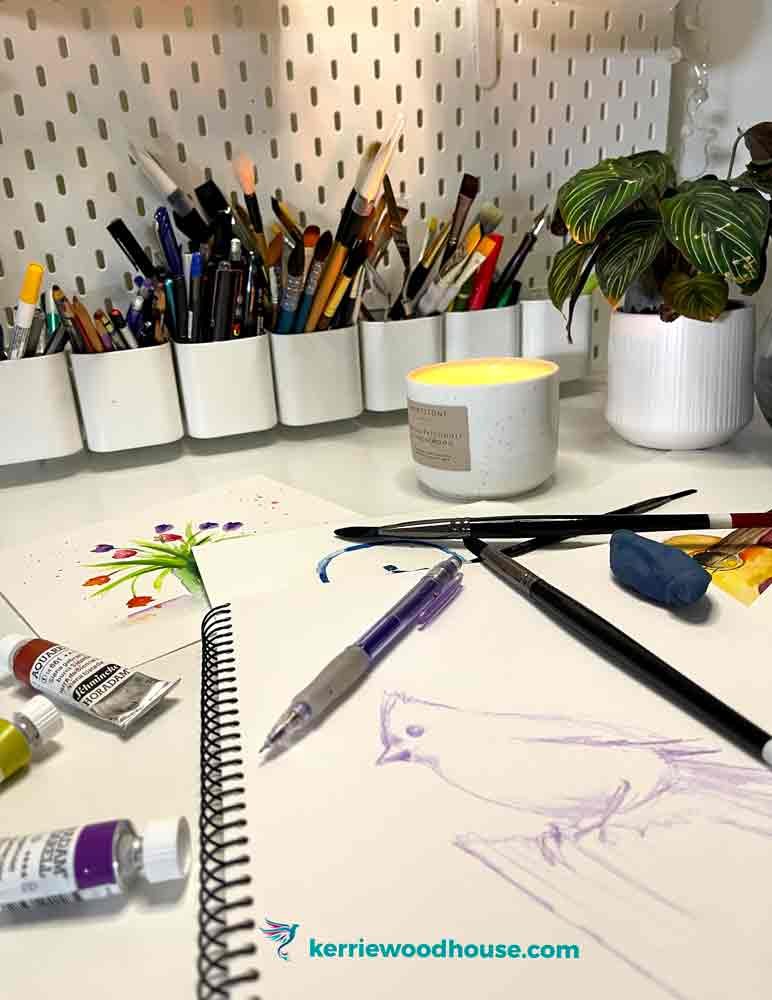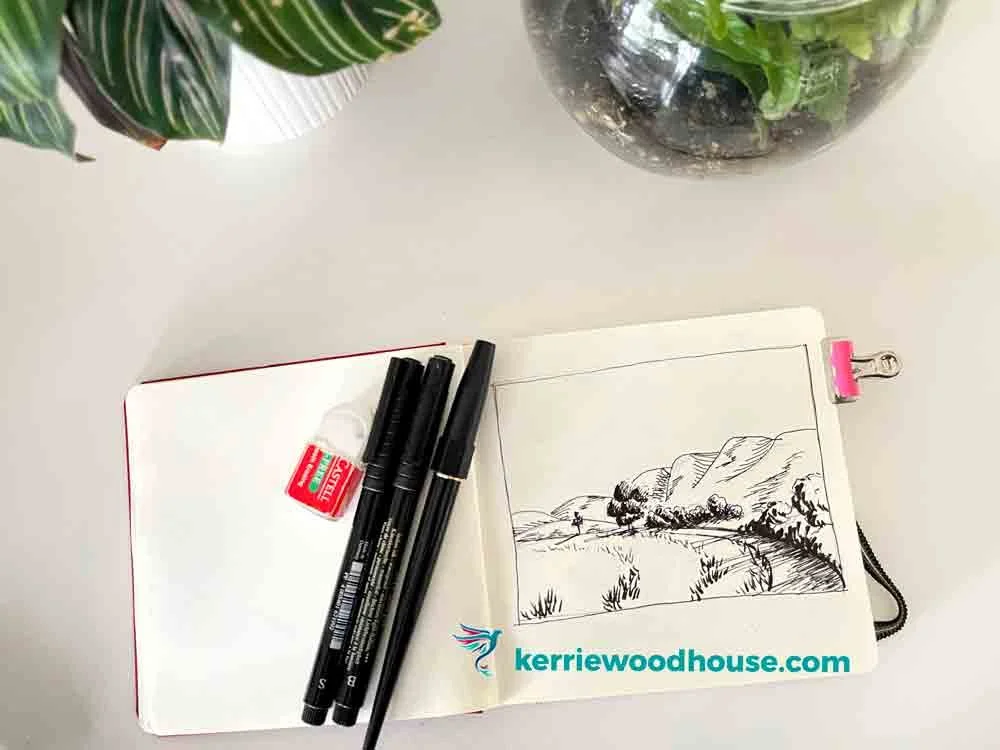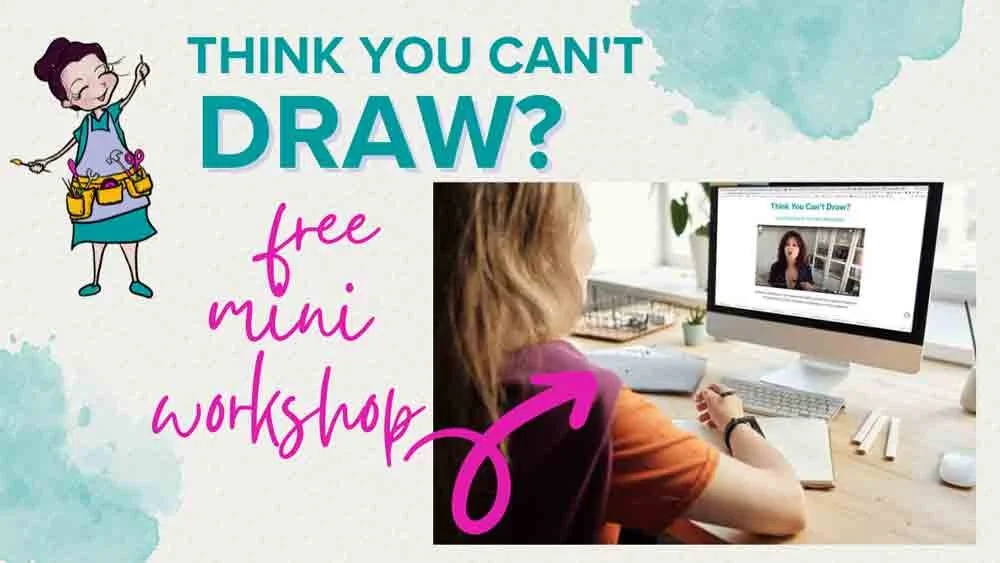Do You Need to Draw to Paint?
If you want to paint with watercolour, do you need to be able to draw?
Well, in short no.
But why wouldn’t you want to?
There are a few options available to get you painting even if you feel you can’t draw yet, which we’ll discuss.
But please know that being able to draw provides a satisfaction that is hard to beat. (And it’s really not as hard as you may think.)
Let me explain.
If you want to get started with watercolour painting but doubt your ability to do the drawing part, please don’t let that stop you! You do have options.
You can always enjoy the fascinating textures and washes of glorious watercolour painting by creating a little abstract artwork. And if you do want to try your hand at representative art then you have the option of tracing especially if someone is kind enough to offer you their line drawings to work from.
Even though you don’t NEED to be able to draw well to enjoy painting, you really might WANT to!
Drawing is a very liberating skill to have (and it's easier than you might think).
It’s rather self affirming to have the confidence to use a line made by your own hand to capture something dear to your heart… or just something in front of you in your own way, and for no other reason than because drawing is fun.
Drawing is not just fun - it's good for you. Of course it is, because fun is good for you.
But I really think there is more to it than that. To draw, the most important thing you need to be able to do is observe. Really look at a subject, notice and appreciate all its details, both the obvious and the subtle.
Psychologists and monks would call that mindfulness, I believe.
And I can’t think of a lovelier way to practise mindfulness than with a little drawing or painting.
Never underestimate the benefit of being able to slip away from the everyday stresses we all endure by allowing ourselves to be completely absorbed by an enjoyable task for a few moments. Not to mention the added bonus of developing a new creative skill.
I digress - let’s get back to the difference between drawing and painting, which is something of a blurry distinction for me.
When people talk about being able to draw what they usually mean is the initial sketch. The ability to make a pencil drawing of the basic outline of a subject with sufficient detail and accuracy for it to be recognisable.
The thing is, the skills you need to be able to do that are also used in the painting process. Sometimes the stage after the initial sketch is called rendering.
You can render (ie fill in all the details of your subject) in the drawing medium. You know those amazing pencil sketches. The ones that are a finished artwork completed in nothing more than say, graphite pencil.
Sometimes you see them in pen, or in charcoal. It's the same thing - the artist chose a drawing medium and completed the whole artwork in just that medium.
Now I can’t say that I am the sort of artist to produce amazing graphite sketches, but I can show you what I mean about the different ways to render an image using different media. I consider them all to use skills you might think of as ‘drawing’ skills. Its just that each one offers a different set of marks and properties.
Take that simple little landscape line drawing we saw above. That’s what I call the initial sketch. The sort of thing I would do in pencil (I choose coloured pencil over graphite if you were wondering) before switching over to paint.
If you like watercolour you can choose to switch from a drawing medium like pencil to watercolour paint at some point in the process. Some do this so early in the sketching process that the initial pencil marks are not really visible in the finished piece.
Some artists like to do all the details in a drawing medium, like ink pen, and then use the paint just to add a little colour. (That technique is called Line and Wash - click here for a whole post and a video about that.)
Let’s not forget that you can actually draw with paint too.
A pencil sketch is not an essential start to a watercolour painting. You always have the option to jump right in with paint. This is called direct painting. It requires boldness and confidence but can be ever so rewarding.
I like to think of painting as a more efficient form of drawing.
When you draw with something like a pencil or a pen you are limited to the lines and dots that your pencil or pen can make. You can only use those marks that your drawing tool is capable of making to finish your drawing.
It's possible of course, but usually quite time consuming. It also relies on a good knowledge of your chosen drawing supply and the techniques specific to that drawing supply.
Using a pencil or pen means that you only have the few lines and marks the pen or pencil can make at your disposal. So you have to wrap a line around the outside edge of your subject to create a big shape and then decide how to fill it using the limited variation of line and dot available to you.
Here is that little landscape sketch from above that I completed using only the coloured pencil I like to sketch with.
A pencil, or coloured pencil, allows you to use lines as well as shading in sections to varying degrees of light or dark. Even in monochrome, it is possible to create an image that is recognisable, has depth or volume and even suggests a bit of texture. (And yes, of course, you could get out your coloured pencils and finish the whole thing using those.)
Pens come in varying thicknesses, and one of the ways that you can render a little sketch like this is to use simple black ink pen. If you have a thicker pen available it can be a little more efficient than having to create those broader marks by colouring in sections with the fine pen.
And now we get to my point about painting. While a range of pen thicknesses gives you some more options at the rendering stage, brushes usually offer more line variation from a single brush.
With a brush you can usually paint in a big mass shape quickly easily. And let's not forget that you are adding colour at the same time!
Brushes also come in different shapes and sizes for even more diversity of mark making. Even a typical round watercolour brush will make a good deal of interesting marks - both fine detailed ones and big juicy broad ones. Those big broad marks make paint a more efficient ‘drawing’ tool.
You are still drawing, in my opinion, you are just using a different approach to achieve the final rendering.
If you don’t feel confident about drawing now, please don’t let that stop you from trying your hand at painting.
Everyone starts somewhere, and even if you don’t do the drawing yourself, you will start to practice some of the fundamentals skills as you learn to paint. I don’t believe there is any shame in tracing (I have much more to say about that but that's in a different post which you can find here) and a painting itch should always be scratched!
But even if you are tracing now, don’t discount the possibility that you can do the drawing.
If you doubt your skills there is a quick test you can do to see if you have what it takes to learn to draw. It’s in a little workshop that I think you will enjoy.
It is free.
It is fast, and it will :
let you take the test to see if you have what it takes to be able to draw
teach you the Golden Rule of Drawing and even
offer a pro trip to take your drawing to the next level.
If that sounds like something you would like pop your details in the form below and I will send it to you by email !
I’d LOVE to hear about the new free mini workshop called ‘Think You Can’t Draw?’
Are you on your own painting journey?
One of these might be useful…













